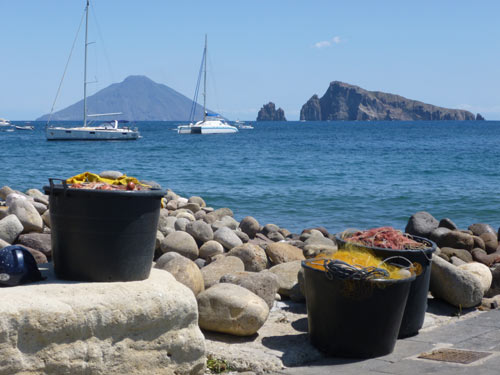For an elegant island escape, Panarea is the perfect destination. Everyone knows the jet-set visit Capri. But outside Italy, not everyone knows that they also holiday on Panarea, in the Aeolian islands off the coast of Sicily. This chic little island attracts VIPs, celebrities and Italy’s wealthy youth, who come in the summer for yachting breaks, romantic escapes and late-night partying on terraces with views.
Although Panarea has evidence of a long history, notably the ruins of a Bronze Age settlement, the profits of tourism mean there’s not much of the gritty or authentic left of Panarea nowadays. The island’s scattered settlements are pretty without that southern shabbiness you’ll find on the other islands; its simple white-washed buildings are surrounded by beautiful flowers and often shuttered, awaiting their wealthy mainland owners. In August you won’t find a great deal of peace at night.
But despite – or because of – the annual summer invasion of a chic elite, the island is charming, with freshly-painted walls, tidy gardens and well-kept lanes setting off the natural attractions of Panarea. There are no big or glitzy hotels here, and no ugly developments; Panarea’s visitors are looking for simplicity and low-key charm. While prices may be high and some of the visitors annoying in the peak season of July and August, outside this period the island is a peaceful paradise at a very reasonable price. Visit in May, June or September and you’re likely to find sunshine, beauty, tranquillity, sea-views and an air of charmed exclusivity mixed with island simplicity – all within a moderate budget.
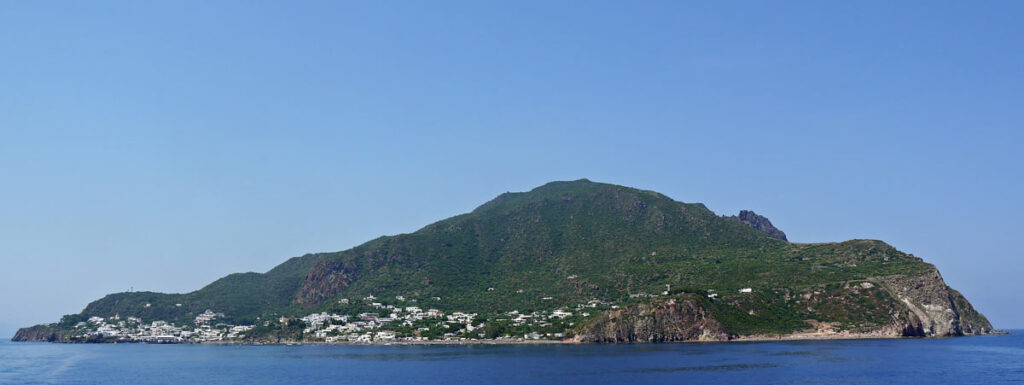
Why visit?
There isn’t a great deal to do on Panarea itself. The island is very small, and best for relaxation. It makes an ideal location for a honeymoon or romantic getaway, or a good rest stop for a couple of nights if you’re touring Sicily. It is one of my favourite destinations for a getting-away-from-it-all break – and not just for relaxing; there could hardly be a better place to sit and work at a table with a view.
The combination of natural beauty, island charm and a couple of the most picturesquely-situated hotels in Italy must be close to unbeatable. There aren’t many places where you can enjoy a bedroom with a terrace looking out directly over the sea, a swimming pool at the water’s edge and romantic waterfront views all at such reasonable prices and so far from the crowds. The island also boasts one of the few sandy beaches in the Aeolian islands, scenic footpaths and accessibility by boat to the other Aeolian islands.
Panarea offers:
– Island charm
– Bronze age ruins
– A small sandy beach
– Photo opportunities
– A day’s hiking
– Pottering
– Hotel pools and sea views
– Excursions to the other islands
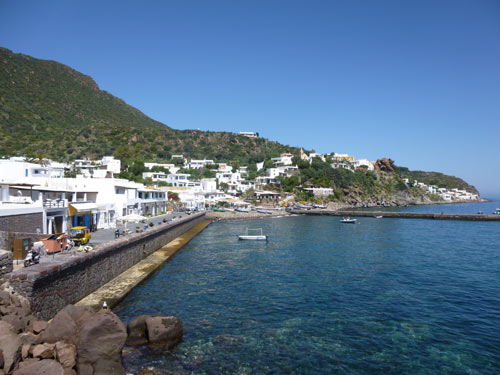
Exploring Panarea
Ferries land at a jetty which is Panarea’s only port, surrounded by a village called San Pietro. From here a narrow lane leads north and south, heading through scattered dwellings which officially form two other nucleii, the villages of Iditella to the north and Drauto to the south. Most accommodation is close to the port at San Pietro.
Panarea has a network of mule paths, mostly fallen into disuse and overgrown, but a few of which are still cleared and in regular use. The walking route up from the harbour to the island’s summit, Punta del Corvo, is straightforward but a heart-burstingly tough climb if attempted at speed on a hot day (or so I found it). If you’re feeling energetic, though, you’re rewarded with great views of the other Aeolian islands. You can do this walk as part of a panoramic circular route which will lead you on downhill from the summit to the southern end of the island. This footpath is fine, though it is near the cliff edge and can feel exposed in places. The descent continues through old agricultural terraces where donkeys graze. Here you’ll find a lovely pebble beach in a dramatic rocky cove called Cala Junco, which is one of the sights of Panarea. One of the most significant archaeological sites in the whole archipelago is located alongside.
The Bronze Age settlement of Capo (or Punta) Milazzese is dramatically situated on a flat-topped headland high above the sea overlooking Cala Junco, and is connected to the rest of the island only by a narrow neck of land. It consists of more than twenty dry-stone hut circles; just low walls but very evocative of a distant way of life. The settlement was excavated in the twentieth century, and archaeologists gave its name to a phase of development in the local Bronze Age, the Milazzese period. It’s thought that the village was abandoned after a sudden and violent destruction.
Walking back from Capo Milazzese towards the port, the footpath descends to a sandy beach, Caletta dei Zimmari. Small and pretty, this is one of the best beaches in the islands. Its sand is narrow but is an excellent place to spend the morning before day-trippers reach the island. The beach is connected with the main settlement of San Pietro by a picturesque lane which passes through the scattered dwellings of Drauto, winding between white walls, villas and bougainvillea. There are one or two places for refreshments on the walk. If you don’t fancy the mountain hiking, a simple stroll from the port along the lanes to the Capo Milazzese and back still makes for an enjoyable excursion, and only takes about half an hour each way (less if you are only heading as far as the beach).
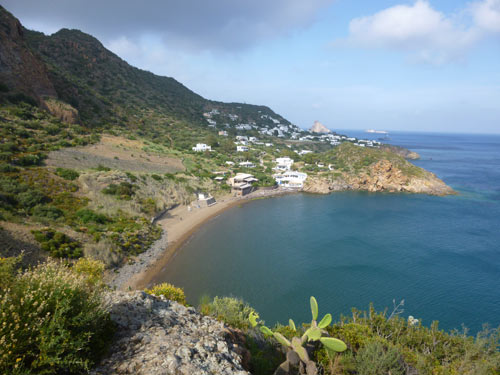
It’s easy to spend a half-hour exploring the lanes and waterfront of San Pietro, with its little boutiques and many picturesque corners. This island is a photographer’s dream.Walking northwards – taking the steps near the jetty – you reach the next settlement, Iditella, where steps lead down to a waterfront where posh villas give way to working areas of boatyards and piles of fishing tackle. Alternatively by continuing on the contouring road you can walk to another of Panarea’s attractions, albeit a fairly undramatic one. At Calcara by the sea, down a zigzag footpath, there are fumaroles which provide a reminder of the volcanic character of these islands. A distinctive rotten egg smell issues from the fumaroles, which are surrounded by mineral deposits. A rocky headland on the way is another atmospheric spot to visit; it has the strange feel of a giants’ fortress.
After these excursions, Panarea’s other attractions are simple: sitting with an aperitivo and watching the setting sun light up Dattilo, a triangular off-shore rock stack; watching dark puffs issue from the crater of Stromboli across the water; marvelling at colourful flowers; dining at one of the nice restaurants which cluster around the port on panoramic terraces; eating a picnic lunch on your balcony looking at the sea. At night, if you’ll be walking far, take a torch. The island isn’t illuminated, which gives it another big attraction: starlight. Overhead at night the sky is full of stars and strolling home by starlight through the pretty villas is impossibly romantic.
If you get cooped up, there are boat trips in the busier parts of the season allowing visitors to explore the other islands – or of course as a cheaper option, you can take the regular hydrofoils or ferries. One of the easiest and most interesting outings is a trip to Stromboli where you can watch the volcano’s eruptions from a boat by night. On the way to Stromboli you pass Basiluzzo, a small rocky islet which is now uninhabited, but boasts the ruins of a Roman villa. Other activities include canoe excursions and diving, which can be arranged locally.
You might fear that every paradise comes with its drawbacks. Panarea, fundamentally, has two. One – unless this is actually what you’re looking for – is the party scene in July/August. This is easy to avoid however, and May/June/September are better months for Italian travel, anyway. The other drawback is the regular deluge of tour boats from the mainland and larger islands. After a swim in the sea at Cala Junco, these boats – some of them massive – disgorge their passengers at Panarea’s harbour in the early afternoon, and for two or three hours day-trippers swarm over the settlement and the road to the beach. A disgruntled islander told me that there can be up to 5,000 visitors a day in summer. If you’re staying on Panarea, though, you’ll pick up the rhythms of the island and can plan around the afternoon invasion. The hottest part of the day is in any case a good time to retreat to the calm of your hotel. You can relax by the pool or on a shady terrace, and feel – if you choose – enjoyably privileged compared to the day-trippers who can only spend a couple of hours in this idyll.
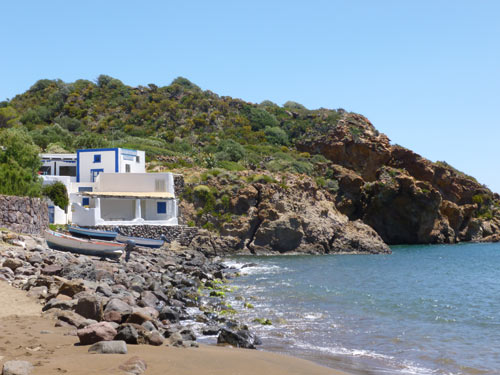
Practicalities
Panarea lies between Stromboli and the cluster of southern Aeolian islands. It has one small port, with only a couple of ferries per day in the quiet season, so plan your journey in advance; you may need to spend a night in Catania, Milazzo or Lipari en route. Golf-buggy taxis, parked by the quay, transport tourists around the island’s minimal road network when required. The only other vehicles on the island are the residents’ scooters and a few golf buggies and tiny 3-wheeled trucks. It’s a small island and distances are walkable.
Eating is one of the pleasures of the island. Panarea has a good selection of pretty restaurants and bars with terraces close to the harbour, with lovely views. Some are chic and expensive, others more homely – visitors can take their pick. For reasonable prices, Da Francesco is a good option for a hearty meal. A short walk out of the centre – up the stepped alley to the right as you land on the island, and then along the road – Da Paolino is another restaurant with a simple trattoria atmosphere, and a terrace with views of Stromboli. Walking back at night (take a torch) is breathtakingly lovely, with the sky full of stars, the moon reflected in the sea and the island buildings lining up in silhouette like a fantasy storybook.
Tasty picnic lunches are easily obtained in San Pietro. There’s an expensive little general store on the seafront, and another on an inland street uphill from the harbour, where you’ll also find a bakery, a takeaway serving arancini and pizza slices and the island’s post office.
The island pretty much closes down in winter, and hotels and restaurants will be closed. May, June and September are the best months to visit. Bear in mind that prices are fairly high on the island, both because of the difficulty of bringing supplies to the island, and because it caters to the yachting set. Nevertheless, it’s not extortionate and you can live reasonably with a picnic lunch, a trattoria dinner and a sundowner as you watch the lovely sunset light from the waterfront (glasses of wine from about 5 euros). Once you’re on Panarea, your hotel terraces, pool, strolling around, visiting the archaeological site or sitting on a towel on the beach won’t cost anything extra.
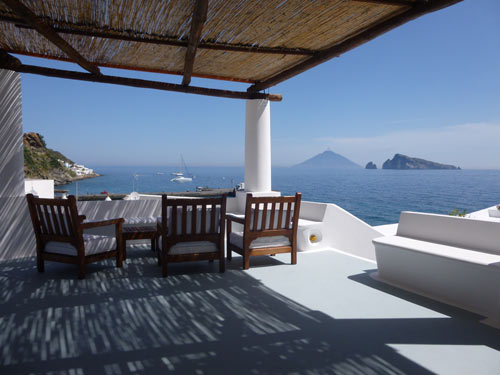
Panarea tips
I really can’t recommend Panarea highly enough as an indulgent ‘getting away from it all’ destination. It’s an amazing idyll, whether you’re with a loved one or looking for some time on your own, free from stress. Bring a camera, a book, a torch and swimwear, plus sensible footwear for walking. And binoculars if you like looking at bird life or billionaires’ yachts.
A typical day on Panarea might begin with breakfast on a terrace overlooking the sea, before a stroll along to the beach and an hour or two spent relaxing or having fun in the waves. After a picnic lunch by the beach or on your private terrace, an afternoon by the pool or reading a book could be followed by another stroll once the day trippers have gone. Then an aperitivo by the harbour and dinner on a restaurant terrace make the perfect way to round off the day.
On one occasion I travelled on to Stromboli on the slow ferry which transports lorry-loads of provisions to the islands. I was the only passenger apart from lorry drivers, and I sat on an upper deck watching Panarea dwindle behind us, and Stromboli increase in size ahead of us. We stopped off at the tiny settlement of Ginostra on Stromboli before following the coastline around to the main port on the far side of the island. If you can allow the time, the slow ferry is a much more scenic experience than the faster, enclosed hydrofoil.
Hiking up to Punta del Corvo – directions
To walk up to the island summit, prepare yourself with good walking boots or shoes, sun protection and a supply of water and food. Take the central street heading up inland from the waterfront at San Pietro. Follow it around to the left. Past an orange-painted-trim building (which houses a takeaway), take an alley on the right – there’s a tiled signpost. The alley passes a tabacchi/souvenir shop. Where it meets a lane, cross straight over and continue. This path ends in a gateway to a private area (the pool of the Hotel Raya). The footpath is hidden away on the right, with a signpost. This climbs and climbs right up to the highest point on the island; ignore the turnings on the way. From the summit, a path heads down to the left (south) hugging the cliff’s edge, and leads around the coast to Cala Junco and the prehistoric village. An alternative route, branching off on the way down, heads eastwards. Visiting in early summer I found the other island footpaths I explored were overgrown enough to be impassable, at least in parts. Teams of volunteers visit the island to clear routes on occasions, though, so if you’re a keen walker it’s worth asking locally about viability, or exploring with care.
Travel to Panarea
You can find more information on reaching the Aeolian islands from Sicily, Italy and other countries on the Aeolian Islands homepage. Panarea lies between the island cluster of Vulcano-Lipari-Salina and the north-eastern Stromboli. From the main departure port of Milazzo (in Sicily), ferries and hydrofoils to Stromboli call in at Panarea on the way. Note that Panarea has fewer connections than the larger islands, and especially if you travel out of peak season, you should check ferry times carefully in advance. In the summer Alilauro run services from Naples which call at Panarea.
As always when visiting islands, bear in mind that high winds and stormy seas can lead to the cancellation of hydrofoil services and also, less often, of the larger ferries which shuttle between the islands. It’s a good idea to travel with a flexible attitude and be prepared for disruptions. If you run into difficulties with ferries, island hotels are knowledgeable and efficient at sorting out travel arrangements, so call ahead for advice.
Where to stay on Panarea
There are only a very few hotels on Panarea, so book ahead. Prices can be very high in the peak season, and there’s next to nowhere open in winter, but to fill bedrooms in other months prices are hugely reduced. As there’s not a great deal to do on the island, it’s worth choosing a hotel with lovely rooms and terraces, and paying extra for a sea view in order to make the most of a special stay. Note that the hotels are, like the island ambience, elegant in a low-key island style, rather than luxurious. They offer white-washed terraces decorated with flowers and simply-furnished tiled bedrooms, rarely anything fancier.
The most attractively-located hotels are the Cincotta, Raya and La Piazza, all of which are situated on the headland to the left as you land at the port. I’ve stayed at La Piazza and Cincotta, both of which have lovely seawater swimming pools on the rocks above the shore, terraces with views and nice outdoor public areas. The Cincotta has the best seaview rooms – almost directly above the water – and also the benefit of terraces facing different directions from the headland, so you get a range of glorious views and can admire yachts at their moorings, Stromboli, the activity at the port or the swimming pool depending on where you choose to sit.
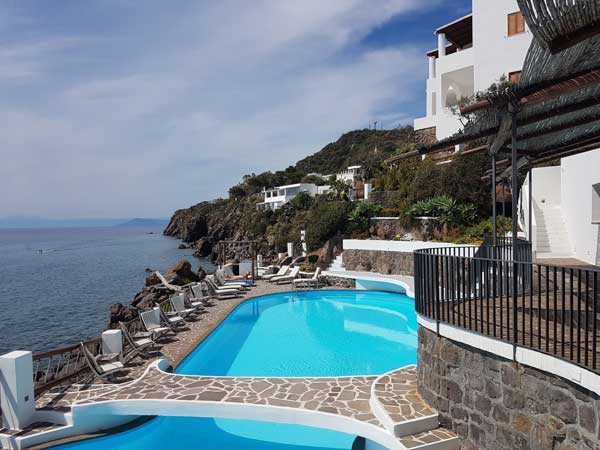
Panarea hotels
Hotel Cincotta
This lovely hotel is situated on the headland to the south of the port. It’s fairly simple while still being classy – a very Italian combination – and has panoramic terraces decorated with exotic flowers. Rooms very in price – I’d recommend paying for a sea view, as these rooms look directly out over the rocks and the sea, and are incredibly romantic. The hotel has a picturesque swimming pool, friendly staff and an ideal position. I’ve stayed there at least three times and loved it.
> More information / make a booking
Hotel La Piazza
Alongside the Cincotta, the Hotel La Piazza also has a lovely sea-water swimming pool with loungers right above the rocky seashore. It also has a smart restaurant terrace with sea views, helpful staff, a spa suite, and a range of rooms with terraces facing the sea. My room was fairly basic, and its sea view was partly obscured by plants growing up the arches of the terrace. I’d say the Cincotta has the edge, chiefly because of its superior situation on the headland with views in more directions. But this makes a good alternative.
> More information / make a booking
There isn’t much accommodation on Panarea, and sea-view hotel rooms are limited, so I’d recommend booking well in advance of your travel to be sure of the best choice.
On this site
South to Calabria: a travel itinerary finishing in the Aeolian Islands
Hotels in Italy – what to expect
Useful external links
Panarea hotels, villas & apartments
Air Panarea (helicopter connections)
Ferries
